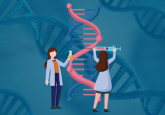Faster and easier discovery of DNA-binding motifs

Researchers have devised a semi-automated technique for the rapid and cost-effective characterization of the DNA-binding specificities of transcription factors.

A complete understanding of the complex circuitry governing gene expression in mammalian cells requires identifying the DNA-binding sites of all transcription factors (TFs) in the cell. But so far, less than half of the DNA targets of mammalian TFs have been determined so far.
Discovery of these remaining DNA-binding sites has been hindered by the complexity and low throughput of standard methods for identifying them. In addition, many studies have only assayed a single TF at a time, which precludes the identification of sites binding TF heterodimers that have different binding specificities than their component TFs.
Now, Alina Isakova and colleagues at the Institute of Bioengineering, Ecole Polytechnique Federale de Lausanne describe a semi-high-throughput, microfluidics-based method for discovering the DNA-binding sites of monomeric and dimeric TFs. The microfluidic platform, which greatly reduces the hands-on time and required volumes of sample and reagents, allows for the immunocapture and physical trapping of full-length TFs that have selectively bound DNA from a pool of random DNA sequences. The bound DNA is then eluted, amplified, sequenced, and analyzed with a customized TF-motif discovery software.
Using their method, the authors systematically characterized the DNA-binding motifs of homo- and heterodimers of the JUN-FOS family of TFs and also discovered the previously uncharacterized DNA-binding specificities of a family of human C2H2 zinc-finger TFs.


